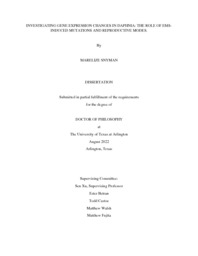
ATTENTION: The works hosted here are being migrated to a new repository that will consolidate resources, improve discoverability, and better show UTA's research impact on the global community. We will update authors as the migration progresses. Please see MavMatrix for more information.
Show simple item record
| dc.contributor.advisor | Xu, Sen | |
| dc.creator | Snyman, Marelize | |
| dc.date.accessioned | 2022-09-15T13:55:48Z | |
| dc.date.available | 2022-09-15T13:55:48Z | |
| dc.date.created | 2022-08 | |
| dc.date.issued | 2022-08-03 | |
| dc.date.submitted | August 2022 | |
| dc.identifier.uri | http://hdl.handle.net/10106/30971 | |
| dc.description.abstract | Gene expression variation is a common source of phenotypic variation between species. Understanding how changes in gene expression are associated with a particular phenotype will aid in understanding the molecular basis and evolution of complex traits. For the first chapter, I investigated the role that changes in gene expression play in the origin of obligate parthenogenesis using the microcrustacean Daphnia pulex. I conducted a genome-wide differential expression and splicing analysis comparing early subitaneous and early resting egg production in OP D. pulex isolates to investigate the genes and mechanisms underlying these parthenogenetic modes. Results from the KEGG pathway and GO term enrichment analysis revealed that early subitaneous egg production is associated with an upregulation of meiosis and cell-cycle genes as well as genes mapped to sugar and lipid metabolic processes. Downregulated genes were enriched in various metabolic processes, biosynthesis, and signaling pathways. For the second chapter, I developed a forward genetic screening approach utilizing EMS mutagenesis in Daphnia to study gene function. First, I showed that 10mM and 25mM EMS concentrations significantly elevated the base substitution rate of multiple Daphnia species to 1.17×10-6 and 1.75×10-6 per site per generation respectively, and that the base substitutions were dominated by G:C to A:T transitions. Furthermore, we showed that EMS-induced mutations were present in the first three consecutive broods of an exposed female, and additionally recommend screening 4-5 F2s generated from sibling crosses per F1 mutant line to detect EMS-induced mutations in the homozygous state with a 70-80% probability. For the last chapter, I studied the effects of EMS-induced mutations on gene expression. First, EMS-induced mutations were identified along with differentially expressed (DE) and spliced (DS) genes. Next, we showed that among the DE and DS genes, a median of 51 and 12 genes were impacted by EMS-induced mutations per mutant line respectively. Of the DE genes, most of these variants were modifier variants (83%), followed by moderate impact variants (10%), low impact variants (6%), and high impact variants (1%). The DS genes were mainly impacted by modifier variants (64%) and moderate impact variants (22%). | |
| dc.format.mimetype | application/pdf | |
| dc.language.iso | en_US | |
| dc.subject | Daphnia | |
| dc.subject | Obligate parthenogenesis | |
| dc.subject | Mutagenesis | |
| dc.subject | Forward genetic screen | |
| dc.subject | Meiosis | |
| dc.subject | Cell cycle | |
| dc.subject | Ethyl methanesulfonate | |
| dc.title | INVESTIGATING GENE EXPRESSION CHANGES IN DAPHNIA: THE ROLE OF EMS-INDUCED MUTATIONS AND REPRODUCTIVE MODES | |
| dc.type | Thesis | |
| dc.degree.department | Biology | |
| dc.degree.name | Doctor of Philosophy in Quantative Biology | |
| dc.date.updated | 2022-09-15T13:55:49Z | |
| thesis.degree.department | Biology | |
| thesis.degree.grantor | The University of Texas at Arlington | |
| thesis.degree.level | Doctoral | |
| thesis.degree.name | Doctor of Philosophy in Quantative Biology | |
| dc.type.material | text | |
| dc.creator.orcid | 0000-0002-1051-3008 | |
Files in this item
- Name:
- SNYMAN-DISSERTATION-2022.pdf
- Size:
- 4.754Mb
- Format:
- PDF
This item appears in the following Collection(s)
Show simple item record


